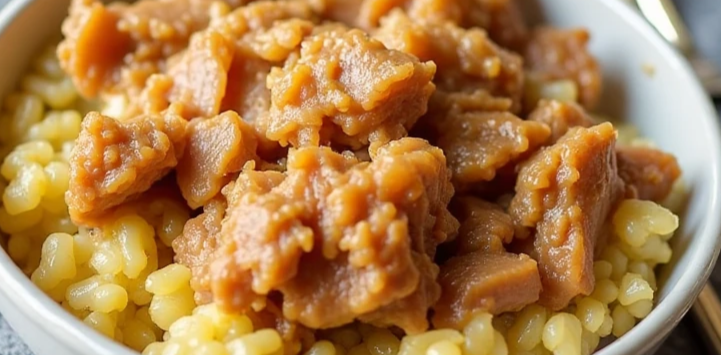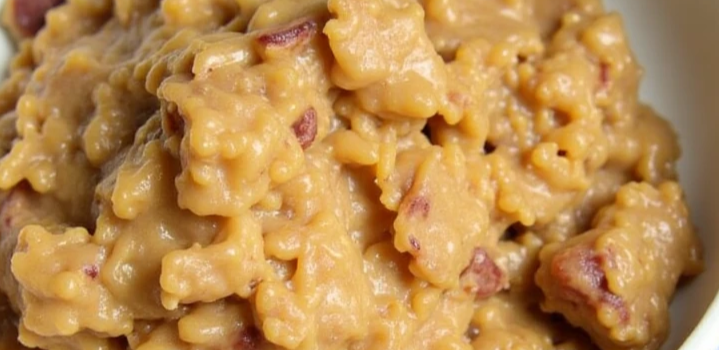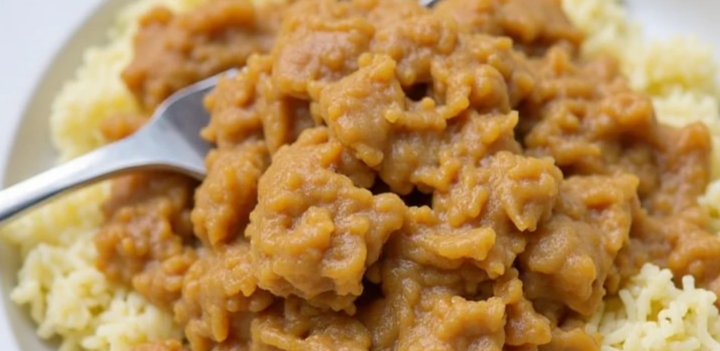Slow Cooker Pork and Sauerkraut Recipe – Traditional, Easy, and Full of Flavor

There’s something deeply nostalgic about pork and sauerkraut simmering away in a slow cooker—it brings back memories of family dinners, cozy kitchens, and meals that mean more than just food. As a chef working in the heart of New York, I’ve learned to appreciate the kind of recipes that are both humble and powerful—ones that respect tradition but still fit into modern life. This slow cooker pork and sauerkraut recipe is exactly that: simple to prepare, rich in flavor, and rooted in generations of heritage. Whether you’re making it for a holiday tradition or just a hearty midweek dinner, it delivers all the depth and comfort you could ask for—without tying you to the stove.
- Slow Cooker Pork and Sauerkraut – A Tradition Made Easy
- Ingredients for the Perfect Pork and Sauerkraut Recipe
- Ingredient Substitution Guide
- Step-by-Step Slow Cooker Instructions
- Flavor Layering Techniques for Slow Cooking
- Cooking Time and Temperature Details
- Nutritional Information
- Storage, Freezing, and Reheating Tips
- What to Serve with Pork and Sauerkraut
- Creative Leftover Ideas
- Regional and Cultural Variations
- Common Mistakes and How to Avoid Them
- Frequently Asked Questions (FAQ)
Slow Cooker Pork and Sauerkraut – A Tradition Made Easy
Why This Dish Is a Comfort Classic
Pork and sauerkraut isn’t just a meal—it’s a feeling. It’s the kind of dish that smells like home before you even open the front door. When I first started cooking professionally, I noticed how often people gravitated toward simple recipes that brought them back to childhood. This one has that effect. The savory pork, the tang of the sauerkraut, the way it all slowly melds together over hours—it’s hearty, warming, and deeply satisfying.
What makes this recipe truly timeless is its balance: protein-rich pork, fermented sauerkraut with gut-friendly probiotics, and simple aromatics that don’t overwhelm. In many kitchens, this would require watching a pot for hours. But with the slow cooker, we bring the same flavor without the effort.

The Symbolism of Pork and Sauerkraut on New Year’s Day
If you’ve ever spent New Year’s Day in parts of Pennsylvania, Ohio, or anywhere with strong German or Eastern European roots, you’ve probably heard someone say: “Pork and sauerkraut brings good luck for the new year.” And it’s more than just folklore.
Traditionally, pork symbolizes forward movement—since pigs root ahead with their snouts—while sauerkraut, made from cabbage (a symbol of prosperity), represents wealth and health. It’s no wonder so many families serve this dish every January 1st.
As a chef, I love how this dish connects food to ritual. It’s not just about feeding the body—it’s about feeding hope, warmth, and the comfort of continuity. Whether or not you believe in the luck, you’ll absolutely believe in the flavor.
Ingredients for the Perfect Pork and Sauerkraut Recipe
Traditional Core Ingredients
This dish might feel simple, but the right ingredients make all the difference. I’ve tested dozens of variations in professional kitchens and at home, and I always come back to a core group of staples that deliver the best flavor and texture:
| Ingredient | Role in the Dish | Chef’s Notes |
| Pork Roast (shoulder or loin) | The main protein | Shoulder adds more richness and stays juicy during long cooking |
| Sauerkraut (with brine) | The tangy base | Go for refrigerated, raw kraut if you want deeper flavor |
| Onion | Adds sweetness and body | Yellow or sweet onions both work well |
| Apple | Balances the acidity | Granny Smith for tartness, Honeycrisp for sweetness |
| Garlic | Savory depth | A must in my kitchen—freshly minced, never jarred |
| Salt & Pepper | Base seasoning | Use sparingly—sauerkraut adds saltiness naturally |
| Caraway Seeds (optional) | Traditional spice | Adds earthy, slightly nutty notes that enhance the kraut |
| Brown Sugar (optional) | Balances sharpness | I like a pinch, especially when using very sour kraut |
These ingredients keep the dish grounded in tradition, but they also give you room to customize (which we’ll explore in a minute).
Flavor-Boosting Additions (Apples, Onions, Caraway Seeds)
The real magic happens when you start layering simple flavors intentionally. Apples soften the edge of the sauerkraut and bring a hint of sweetness. Onions, once slow-cooked, melt right into the pork, infusing everything with warmth and depth. And a pinch of caraway seeds? It’s the quiet hero—tying everything together with a note of tradition that makes the whole dish taste like it came from your grandmother’s kitchen (even if it came from a tiny NYC apartment).
Ingredient Variations for Different Preferences
Cooking for kids or someone sensitive to tang? Rinse the sauerkraut lightly to mellow the flavor. Want a smokier taste? Add a splash of apple cider vinegar and a touch of smoked paprika. I’ve even added sliced fennel and beer to the mix for a German-style spin. This dish is more versatile than it looks—and you don’t need a culinary degree to make it shine.
Ingredient Substitution Guide
In every kitchen I’ve worked in, there’s one golden rule: great food should be flexible. Whether you’re cooking with what’s on hand, adjusting for health reasons, or just experimenting with flavor, pork and sauerkraut is surprisingly forgiving. Here’s how to make it work for you.
Leaner Cuts of Pork
Want to reduce fat without sacrificing tenderness? Swap the pork shoulder for a boneless pork loin or center-cut pork roast. These leaner cuts still cook well in a slow cooker, especially when surrounded by sauerkraut’s moisture. Just watch your cook time—loin dries out faster, so check it an hour earlier than you would a shoulder.
Low-Sodium or Mild Sauerkraut Options
Sauerkraut can be salty and intense—too much for some palates. Here’s what I suggest:
- Rinse the sauerkraut briefly in cold water to tame the salt and sourness.
- Use a low-sodium store-bought version or, if you’re adventurous, try making your own at home with just cabbage and sea salt.
- Mix sauerkraut with some shredded green cabbage to dilute the intensity while keeping texture and tang.
Apple Alternatives: Juice, Cider, or Pears
No apples on hand? No problem. I’ve used all of these with great results:
| Substitute | Flavor Effect | How to Use |
| Apple juice | Subtle sweetness | Add ½ cup to replace the moisture of chopped apples |
| Apple cider (non-alcoholic) | Rich, seasonal note | ½ to ¾ cup adds body and balances acidity |
| Pear slices | Softer, floral flavor | Adds sweetness and a gentle texture contrast |
| Apple cider vinegar | For extra brightness | Use sparingly—1–2 tablespoons in the sauce or on top |
I’ve even tossed in dried fruits like apricots or cranberries for a holiday twist—it’s nontraditional, but it works.
Step-by-Step Slow Cooker Instructions
This dish is one of those “dump and go” meals at first glance—but if you want deep flavor and perfect texture, a little prep goes a long way. Here’s how I do it in my kitchen, whether I’m cooking for a quiet dinner at home or prepping for a holiday crowd.
Preparing the Pork (Trim, Sear, or Not)
Start with your cut of choice—pork shoulder for richness, or loin if you want something leaner. If there’s a thick cap of fat, trim most of it off but leave a little for moisture.
Now, some folks just throw it straight into the slow cooker—and you can. But when I want a richer, more developed flavor, I take a few extra minutes to sear the pork on all sides in a hot skillet. That golden crust adds a depth that slow cookers alone just can’t replicate.
If you enjoy that approach, you’ll probably also appreciate how searing works in dishes like slow cooker cubed steak, where browning adds layers of savory flavor even before the slow simmer begins.
If you’re short on time? Skip the sear. The recipe will still come out great.

Layering Sauerkraut and Flavor Enhancers
Once your pork is prepped, grease the slow cooker insert lightly or use a liner (saves cleanup!). Then layer in this order:
- Half the sauerkraut (with some of the brine)
- Sliced onions, apples, and garlic
- Seasonings (caraway seeds, pepper, a pinch of brown sugar if using)
- Pork roast, nestled right in the center
- Remaining sauerkraut and aromatics, covering the pork
- Optional liquid: ½ cup apple juice, cider, or broth for added moisture
Slow Cooking the Right Way
Set your slow cooker based on your timing needs:
- LOW for 8–10 hours (best for pork shoulder)
- HIGH for 4–5 hours (better for leaner cuts)
Don’t lift the lid too often—every peek adds about 20 minutes to your cook time.
Liquid Ratios and Placement Tips
This dish doesn’t need much liquid. The pork and sauerkraut release plenty of moisture. Too much added liquid will water down the flavor.
Pro tip: Place apple slices directly against the pork, not just on top—this helps infuse the meat from the inside out as it cooks.
When to Add Sugar, Mustard, or Spices
If you’re using brown sugar or Dijon mustard, stir them into the sauerkraut before layering. This ensures even distribution.
Spices like paprika, bay leaves, or cloves should go in with the first sauerkraut layer to mellow as they cook. If you like bold spice, add a pinch of crushed red pepper at the end for a little heat.
Flavor Layering Techniques for Slow Cooking
One thing I always tell home cooks: slow cooking isn’t just about time—it’s about timing. You’re not just tossing everything in and hoping for the best. When you understand how flavors develop over hours, you can turn a humble pork and sauerkraut dish into something you’d proudly serve at a dinner party.
Building Depth with Aromatics and Acidity
Every slow-cooked dish starts with a foundation. For this one, that means onions, garlic, and apples. But here’s the trick: place them both under and over the pork. The lower layer helps infuse the sauerkraut, while the upper layer melts into the meat as it softens.
Acidity plays a major role too. Sauerkraut is naturally sour, but pairing it with something mildly sweet (apples, brown sugar, even a splash of cider) rounds the edge without muting the bite. It’s all about finding that sweet-sour harmony early in the layering process.
When to Add vs. When to Wait: Timing Flavors for Best Results
Some ingredients need time to mellow. Others? They’re better added later. Here’s my breakdown:
| Add Early | Add Late (last 30–60 min) |
| Onions, garlic, caraway seeds | Fresh herbs like dill or parsley |
| Sauerkraut, pork, apples | Spicy mustard or vinegar splash |
| Brown sugar, bay leaf | Crushed red pepper or finishing salt |
This staggered approach lets bold flavors settle while delicate ones stay fresh and bright.
Balancing Sweet, Sour, and Savory in a Long Simmer
A common mistake with pork and sauerkraut is letting one flavor dominate. Too sour? It tastes harsh. Too sweet? It’s cloying. You want contrast that evolves bite after bite.
Here’s how I build balance:
- Salt: Only lightly at first. Let the kraut do the heavy lifting. Taste at the end and adjust.
- Sweet: Use just enough apple or sugar to soften acidity—not mask it.
- Umami: A small spoon of Dijon mustard or a dash of Worcestershire can add surprising depth without being obvious.
By layering thoughtfully, you create a flavor story—one that starts bright, ends rich, and keeps everyone going back for more.

Cooking Time and Temperature Details
One of the things I love most about slow cooking is how forgiving it can be—but only when you respect the timing and temperature. Get it right, and the pork practically falls apart with a spoon. Get it wrong, and you’re dealing with dry meat or soggy sauerkraut. Here’s how to dial it in just right.
Recommended Slow Cooker Settings
The cut of pork you choose will determine the ideal cooking time. Here’s my go-to guide:
| Cut of Pork | Setting | Time |
| Pork Shoulder (bone-in or boneless) | LOW | 8–10 hours |
| Pork Loin or Center-Cut Roast | LOW or HIGH | 6–7 hours on LOW or 4–5 hours on HIGH |
| Pork Tenderloin (leanest) | HIGH | 3–4 hours (not ideal for long cook) |
If you’re ever unsure, start checking for doneness 30 minutes before the minimum cook time.
Pork Internal Temperature for Safety and Texture
According to USDA guidelines, pork is safe to eat at 145°F (63°C) with a rest. But for slow-cooked recipes like this, I always aim higher—around 190–200°F (88–93°C). That’s the zone where collagen breaks down, making the meat fork-tender.
Use a digital probe or instant-read thermometer, and check the center of the thickest part of the roast.
How to Adjust Cook Time for Different Pork Cuts
Here are some quick adjustment tips:
- Smaller roasts (2–3 lbs) will cook about 1 hour faster
- Larger roasts (4–5+ lbs) may need an extra hour
- If you’re doubling the recipe, don’t double the time—increase it by about 1–1.5 hours, but watch the internal temp
Slow cookers vary, so if you’re using a newer high-heat model, your pork might finish faster than expected. That’s why I always say: trust your thermometer, not just the clock.
Nutritional Information
Let’s be honest—pork and sauerkraut isn’t trying to be a diet dish. It’s meant to nourish and satisfy. But that doesn’t mean it can’t fit into a balanced lifestyle. In fact, this recipe offers a great balance of protein, healthy fats, and fermented goodness from the sauerkraut. Whether you’re tracking macros or just curious, here’s how the nutrition stacks up per serving (based on 6 servings using pork shoulder and traditional sauerkraut).
| Nutrient | Approximate Amount per Serving |
| Calories | 370–430 kcal |
| Protein | 28–32g |
| Carbohydrates | 10–15g |
| Total Fat | 22–26g |
| Saturated Fat | 7–9g |
| Sodium | 800–1000mg |
| Fiber | 3–4g (thanks to the kraut) |
| Sugars | 5–7g (mostly from apples/onions) |
Calories per Serving
Most of the calories come from the pork and any added fats like oil or butter (if used). Want to cut back a bit? Use pork loin and reduce the sugar or apple content. You’ll shave off 50–80 calories per portion while keeping the dish satisfying.
Protein, Carbohydrates, and Fat Breakdown
This dish is naturally high in protein and relatively low in carbs, especially if served without potatoes or bread. If you’re going low-carb or keto, it fits in nicely—just skip the apples or swap them for celery or fennel.
Sodium Considerations from Sauerkraut and Broth
Sauerkraut can be a salt bomb—especially the canned kind. To manage sodium levels:
- Rinse the kraut lightly before using
- Choose low-sodium broth or skip it altogether
- Avoid additional salt until the end—taste first!
Fermented kraut also supports gut health, so you get a little bonus along with all that flavor.
Storage, Freezing, and Reheating Tips
One of the best parts about pork and sauerkraut—aside from how easy it is to make—is how well it keeps and reheats. In fact, I’ll let you in on a chef’s secret: it often tastes even better the next day. The flavors deepen, the kraut mellows, and the pork becomes even more tender. Here’s how to handle leftovers like a pro.
Best Way to Store Leftovers
Once cooled to room temperature, transfer leftovers into airtight containers. I recommend dividing into single-serving portions—it makes reheating faster and keeps everything fresher longer.
- In the fridge: Keeps for 3 to 4 days
- Storage tip: Always store pork submerged in a bit of sauerkraut and juices to prevent drying out
Reheating Without Drying Out the Pork
Microwaving is fine, but there’s a trick: add a splash of water, broth, or apple juice before reheating to bring back moisture.
- Microwave: Cover loosely and heat in 60-second intervals, stirring halfway
- Stovetop: Reheat gently over medium-low heat, covered
- Oven (best for large portions): Place in a covered dish at 325°F (160°C) for 20–25 minutes
Avoid high heat—it’s the fastest way to dry out even the juiciest shoulder cut.
Can You Freeze Pork and Sauerkraut?
Yes—and it freezes surprisingly well! The texture of the kraut might soften slightly, but the flavor remains excellent.
- Let the dish cool completely
- Pack into freezer-safe containers, removing excess air
- Label and freeze for up to 3 months
To reheat from frozen, thaw overnight in the fridge, then warm gently using the oven or stovetop method. Add a bit of broth if it seems dry during reheating.

What to Serve with Pork and Sauerkraut
Pork and sauerkraut can absolutely stand on its own, but let’s be honest—the right sides turn it into a full experience. Whether you want to keep it traditional or balance the richness with something fresh, here’s how I build the perfect plate around this dish.
Traditional Side Dishes (Mashed Potatoes, Rye Bread)
There’s something about scooping that tender pork and tangy kraut onto a bed of buttery mashed potatoes that just makes the world feel right. It’s the classic for a reason.
Other favorites from my kitchen:
- German-style rye bread or pumpernickel rolls
- Buttered egg noodles (especially popular in the Midwest)
- Boiled or roasted baby potatoes tossed in parsley and garlic
These starchy sides soak up the juices beautifully and round out the meal.
And if you’re looking to add a more refined starch to the plate, take a look at this recipe for perfect basmati rice in a cooker. Its light aroma and fluffy texture make it a beautiful alternative to potatoes or noodles—and a subtle complement to the rich pork and tangy sauerkraut.
Light Vegetable Pairings
Looking for something to brighten the plate? I like to pair pork and sauerkraut with crisp, clean vegetables for contrast:
- Steamed green beans with lemon
- Roasted carrots with honey and thyme
- Shaved Brussels sprouts with apple cider vinaigrette
- Cucumber-dill salad — a nod to Eastern European flavors
These lighter sides help balance the richness without stealing the spotlight.
And if you’re short on fresh veggies, don’t overlook frozen broccoli. It’s fast, convenient, and when cooked right—don’t miss the guide on how to cook frozen broccoli the right way—it comes out crisp-tender and vibrant, adding color and texture to your plate without extra effort.
Beverage Pairings (Beer, Cider, or Wine)
Let’s talk drinks—because yes, pairing matters even with comfort food. Here’s what I pour when serving this dish:
| Beverage | Why It Works |
| German pilsner or wheat beer | Light, crisp, and perfect with pork and fermented flavors |
| Dry hard apple cider | Echoes the apple in the dish and balances the tang |
| Riesling (dry or off-dry) | Acidic and slightly sweet, it holds up well to kraut |
| Light-bodied red wine (Pinot Noir) | Earthy and fruity, complements the pork beautifully |
Of course, a tall glass of iced tea or even sparkling water with lemon works just fine for everyday meals.
Creative Leftover Ideas
Pork and Sauerkraut Sandwiches or Wraps
If you ask me, the mark of a great dish is how well it holds up the next day—and pork and sauerkraut absolutely shines here. One of my favorite leftover moves? Sandwiches. Grab a crusty roll, a slab of rye, or even a warm tortilla, and pile on reheated pork and kraut. The key is contrast: soft, tangy meat meets chewy bread or a crisp wrap.
Want to elevate it? Add a swipe of whole-grain mustard or a sliver of Swiss cheese. In my kitchen, we sometimes add a few pickle slices and serve it pressed like a panini—it’s hearty, satisfying, and completely different from the original plate, but all the flavor is still there.
Hash with Potatoes and Eggs
This one’s a brunch favorite in my home and at the bistro. Take those leftovers, chop the pork into bite-sized pieces, and toss it into a hot skillet with diced potatoes, onions, and a bit of olive oil or butter. Let it crisp until golden and irresistible. Then, crack a couple of eggs right over the top and cover until they’re cooked just how you like them—runny, jammy, or fully set.
The sauerkraut acts like a built-in seasoning, infusing the whole dish with brightness and depth. I sometimes sprinkle in fresh chives or a little smoked paprika to give it a brunchy twist. It’s the kind of meal that makes you want to linger at the table.
German-Inspired Soup Using Leftovers
Leftovers don’t have to feel like a repeat—they can be a reinvention. When I want something warm and cozy that’s a bit lighter, I turn my pork and sauerkraut into a soup. Here’s how: Start with a base of sautéed onions and garlic, then add broth (chicken or vegetable both work). Stir in chopped pork and kraut, then throw in extras like diced potatoes, carrots, or even white beans.
Let it simmer gently until everything melds together. The kraut adds that unmistakable tang, while the pork gives body and richness. A bay leaf or two brings it all home. Finish with a touch of fresh dill or parsley. It’s rustic, hearty, and tastes like something you’d be served in a countryside inn in Bavaria.

Regional and Cultural Variations
Pennsylvania Dutch Style
If there’s one place in America where pork and sauerkraut isn’t just a dish but a ritual, it’s Pennsylvania Dutch country. I’ve had the privilege of cooking for families in Lancaster who wouldn’t dream of starting the New Year without this meal front and center. Their version leans deeply into tradition: bone-in pork shoulder, un-rinsed fermented sauerkraut straight from the barrel, and plenty of caraway seeds.
What sets it apart is the baking. Often, the dish is started in a slow cooker or Dutch oven, then finished uncovered in the oven to caramelize the top layer of kraut. It gives a subtle chew and a deeper, roasted note that’s unforgettable. Sometimes apples are skipped entirely—because “the sauerkraut should bite,” as one home cook told me.
Midwest Family Traditions
In the Midwest, especially around Ohio, Illinois, and Michigan, pork and sauerkraut takes on a cozy, casserole-like tone. Here, families often mix the kraut with mashed or cubed potatoes directly in the slow cooker or bake it all together in a single dish. It’s practical, hearty, and made to feed a crowd.
I’ve seen versions served with egg noodles, dumplings, or even layered into deep-dish pies with buttery crusts. There’s also a noticeable leaning toward mellowing the sauerkraut—either by rinsing it or adding sugar, apples, or even sweet onions. This version is all about comfort, often passed down through generations and brought out for holidays and snow days alike.
Eastern European Influences
As someone who trained under a Polish-born chef early in my career, I quickly learned that pork and cabbage is a staple far beyond American borders. In Eastern Europe—especially in Poland, Slovakia, and Ukraine—this dish takes on many forms: bigos (hunter’s stew), kapusta, or simply roasted pork served over braised sauerkraut with mushrooms and smoked meats.
The use of smoked kielbasa, juniper berries, bay leaves, and even dried plums or wine elevates the flavor into something rich, woodsy, and complex. These versions are less sweet and more savory, often cooked slowly on the stove or in clay pots. When I bring these influences into my New York kitchen, I’m always amazed at how well they blend with American traditions.
Common Mistakes and How to Avoid Them
Mushy Sauerkraut or Dry Pork
This is by far the most common issue I hear about. If the kraut turns into a limp, flavorless mess and the pork is dry or stringy, something’s gone wrong in the setup.
The fix? First, don’t overdo the liquid. Sauerkraut releases a lot of moisture on its own, and adding too much broth, cider, or juice upfront can dilute flavor and drown the texture. I usually add no more than ½ cup of extra liquid, if any at all.
As for the pork, timing and cut matter. Shoulder is your friend—it’s fatty and forgiving. Loin is lean and can dry out, especially on HIGH heat or when overcooked. If using loin, go LOW and check early. And never skip resting the pork after cooking—10–15 minutes under foil lets the juices redistribute.
Overseasoning or Underseasoning
Sauerkraut is already salty and tangy—seasoning becomes a balancing act. I’ve seen folks dump in salt like they’re seasoning pasta water, only to regret it when the whole thing becomes inedible.
My approach? Season conservatively at the start. Let the kraut and pork do their thing, and taste in the final 30 minutes. That’s when you can fine-tune—add a little salt if needed, a touch of sugar if it’s too sharp, or even a splash of vinegar if it fell flat.
Spices also benefit from restraint. A pinch of caraway or paprika can elevate; too much, and you mask the dish’s natural flavor.
Too Sour? How to Balance Acidity
Not everyone loves an aggressive kraut kick. If your dish comes out face-puckeringly sharp, don’t panic—there are ways to bring it back into balance.
First, check your sauerkraut choice. The refrigerated kind tends to be fresher and less harsh than canned. Always taste before you cook with it.
Second, add sweetness mindfully. Apples are my go-to—especially tart-sweet ones like Honeycrisp or Gala. Brown sugar, maple syrup, or even caramelized onions can work in a pinch. Start small, stir, and taste.
Lastly, a touch of creaminess can mellow things beautifully. A swirl of sour cream or a dab of butter right before serving softens the edges and gives the dish a luxurious finish—especially if you’re serving guests who are kraut-skeptical.

Frequently Asked Questions (FAQ)
Can I use pork chops instead of a roast?
Yes, but keep in mind that pork chops—especially if boneless and lean—cook much faster and can dry out in a slow cooker. If you use them, reduce the cooking time significantly and consider searing them first for added flavor and texture.
Do I have to rinse the sauerkraut?
Not necessarily. Rinsing sauerkraut will mellow its flavor and reduce sodium, which can be helpful if you’re cooking for someone sensitive to sour or salty foods. Personally, I prefer using un-rinsed kraut for full flavor, but I taste it first to decide.
Can I make this recipe in the oven instead of a slow cooker?
Absolutely. Use a Dutch oven or deep roasting dish. Cover tightly with a lid or foil and bake at 300°F (150°C) for 3 to 4 hours, depending on the cut of pork. Uncover for the last 30 minutes if you want some caramelization.
What’s the best type of sauerkraut to use?
Look for raw, refrigerated sauerkraut if possible—it’s fresher and richer in probiotics. Avoid overly processed or canned versions unless you plan to build flavor with other ingredients like apples, broth, or onions.
Can I make it ahead of time?
Yes, and I often do. Pork and sauerkraut tastes even better the next day. The flavors deepen overnight, making it a perfect make-ahead dish for holidays or busy weekdays.
What’s the best way to reheat pork and sauerkraut?
Low and slow is key. Use the stovetop or oven for even reheating. If microwaving, cover the dish and add a splash of liquid—like apple juice or broth—to prevent drying out.
How do I keep the pork from getting dry?
Choose fattier cuts like pork shoulder and avoid overcooking. Keep the lid closed during slow cooking, and let the pork rest after it’s done to lock in juices. Also, don’t over-trim fat before cooking—it helps maintain moisture.
Can I freeze pork and sauerkraut?
Yes, it freezes very well. Cool completely, store in airtight containers, and freeze for up to 3 months. Thaw overnight in the fridge and reheat gently with a little broth or juice.
What other meats can I use?
Smoked sausage or kielbasa is a fantastic alternative or addition. You can also try beef brisket, though the flavor profile changes. Chicken thighs work in a pinch but won’t have the same richness.
Is this recipe gluten-free?
Yes, the base recipe is naturally gluten-free. Just double-check that your broth and any mustard or other condiments don’t contain hidden gluten if you’re cooking for someone with celiac disease.
Can I make this dish in an Instant Pot?
Definitely. Use the sauté function to sear the pork if desired, then cook on high pressure for 50–60 minutes with a natural release. It’s faster, but you may need to reduce the liquid since pressure cookers don’t allow for evaporation.
How do I tone down the sourness if I overdid it?
Add sweetness—apples, brown sugar, or even honey. A small splash of cream or a pat of butter stirred in at the end can also soften the edge. If needed, balance with neutral ingredients like boiled potatoes or rice on the side.
What herbs go well with this dish?
Fresh dill, thyme, and flat-leaf parsley are excellent finishing herbs. They brighten up the dish and add a fresh contrast to the rich pork and tangy kraut.
Can I add potatoes or other vegetables into the slow cooker?
Yes, but add root vegetables like potatoes, carrots, or parsnips below the pork so they cook evenly in the juices. Softer veggies like cabbage or fennel should go on top to avoid overcooking.
What should I serve with pork and sauerkraut?
Classic sides include mashed potatoes, rye bread, or buttered noodles. For something lighter, go with steamed green beans or a crisp cucumber salad. Beverage-wise, dry cider or a German pilsner pairs beautifully.







